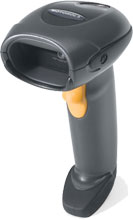Finding the Right Barcode Scanner – What Makes Them Different?

Selecting a barcode scanner may seem like a simple enough task at first glance but given the range of barcodes and how they are used today, it can quickly become a challenge to find the right one. Most scanners today are more than capable of reading well printed barcodes on a typical paper label. That said, uses for barcodes have expanded well beyond basic labels and many specialized scanners are available to meet the needs of specific applications. In the following we’ll cover some key features to consider when trying to select the best fit scanner for your needs.
1D or 2D – Printed or Electronic
Probably the most crucial first step in selecting a scanner is determining what kind of barcodes you will be reading. The traditional picket fence style 1D barcodes are still the most commonly used and are often printed on a label but you will find the use of 2D matrix style codes much more common today. Likewise, you may not just be reading barcodes on a printed label as more applications are embracing scanning off of smartphone screens or from codes directly etched/molded into a product. In the case of simple 1D barcodes on a label, your standard laser of linear imager will readily meet your needs. For 2D barcodes or applications reading from not printed surfaces, a full 2D imager will be needed to properly scan the code. 2D imagers are more costly but their main advantage is that they can essentially omnidirectionally read any barcode from almost any surface.
Ruggedness
Scanners can be found in a wide range of environments from the retail checkout to the warehouse floor and even in extreme outdoor situations. Every scanner is designed to handle an occasional drop or tumble but when this becomes a daily occurrence, purpose built models are available to ensure a better ROI in more demanding environments. The differences between rugged and standard models are actually quite drastic. Ruggedized scanners are completely sealed against dust (IP rated) and with a rubberized case can handle drops to concrete and severe mistreatment. Some models are even designed for healthcare applications with sealed cases that are made of disinfectant ready plastics to ensure that the device can be cleaned regularly without long term corrosion. Depending on the exact environment you’ll be using the scanner in, ruggedness is a feature that will greatly affect the longevity of your scanner and the overall value of your investment.
Reading Performance
Depending on your application, barcode labels can sometimes get damaged, scratched, or dirty making them more difficult to read. In these cases the difference between a laser or imager scanner will be the determining factor in getting a good read. Similarly, barcodes that are etched or are DPM(direct part marking) will require a scanner with a more aggressive 2D imager and robust decoding algorithms to get any readability.
Wireless Pairing
With the ever increasing use of tablets and smartphones in data collection applications, the demand for Bluetooth wireless connectivity in scanners has become even more popular. Even though many mobile devices have buil-in cameras that could be used as basic scanners this option is cumbersome and counterproductive for any scan intensive application. When selecting a device to pair with a tablet or smartphone, the pairing process should be quick, simple, and not limit qany features of the mobile device. Especially in the case of Apple products, many scanners will already be Apple MFi certified to ensure immediate compatibility.
By going through a few key concerns related to how you’ll be using a scanner in your specific application, you’ll be able to easily save time and money while ensuring a long life from your devices.




